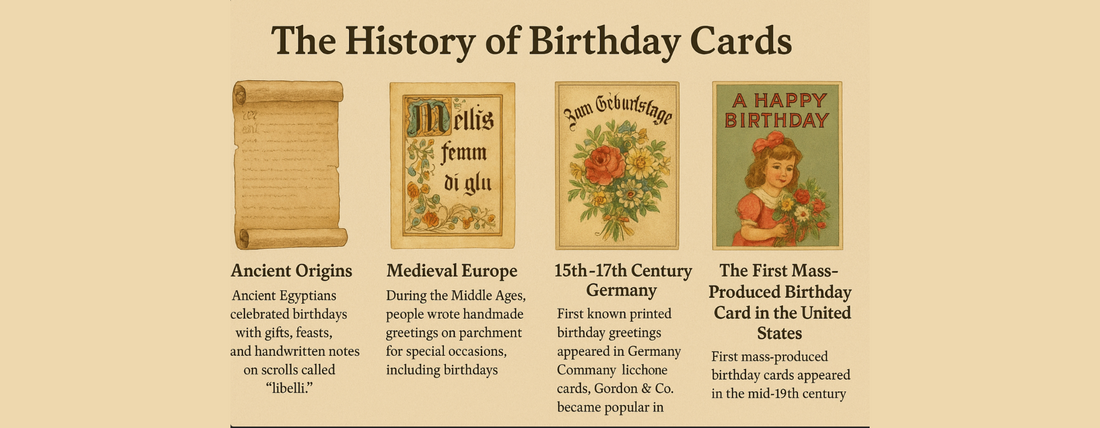
WHO INVENTED BIRTHDAY CARDS? THE HISTORY OF BIRTHDAY CARDS.
Share
Birthday cards, a common way of expressing love and celebration today, have a long and fascinating history that spans centuries. The evolution of birthday cards reflects changes in culture, technology, and commerce. While no single individual invented the birthday card, several milestones mark its development.
1. Ancient Origins: Celebrating Birthdays in Egypt and Rome
The earliest birthday celebrations can be traced back to ancient Egypt. Egyptians celebrated the “birth” of pharaohs, marking their coronation as a divine event. These celebrations involved feasts, offerings, and greetings, though there were no physical cards as we know them.
In ancient Rome, birthdays became more widespread, including for ordinary citizens. Romans often exchanged handwritten notes called “libelli”, which were small scrolls or letters expressing congratulations or good wishes. However, these were handwritten messages, not commercially produced cards. The concept of a personalized greeting for a birthday laid the groundwork for the later development of cards.
2. Medieval Europe: Handwritten Greeting Traditions
During the Middle Ages in Europe, literacy was limited, and books or parchment were expensive. People celebrating important occasions, like birthdays, often wrote greetings by hand on parchment or vellum.
-
In Germany and other parts of Europe, it was common to craft hand-painted notes or calligraphic messages for loved ones.
-
These greetings were highly personal and artistic, sometimes decorated with gold leaf, illustrations, or religious symbols.
-
This period marks the first time written birthday messages became a tradition rather than just spoken congratulations.
While still rare and luxurious, this tradition shows the human desire to express affection through words and art—a precursor to the modern birthday card.
EXPLORE VINTAGE CARD COLLECTION
3. 15th–17th Century Germany: The First Printed Birthday Greetings
The Germans in the 15th century were pioneers in printing birthday greetings. With the invention of the printing press by Johannes Gutenberg in the mid-1400s, the production of written materials became easier and more widespread.
-
Germans began creating “Geburtstagszettel”, which were small printed sheets with birthday wishes.
-
These sheets were often decorated with illustrations, floral designs, and calligraphy.
-
They were shared among family and friends, especially among the wealthier classes who could afford printed materials.
This period represents the transition from handcrafted greetings to the use of printed media, making birthday messages more accessible and less time-consuming to produce.
4. 19th Century England: Commercialization of Birthday Cards
The 19th century saw the mass production of birthday cards in England, thanks to the industrial revolution and advances in printing technology, such as lithography.
-
Companies like Gordon & Co. and other printing houses began producing ready-made cards, often featuring intricate designs, poems, and decorative elements.
-
The commercialization made birthday cards affordable for the growing middle class, who could now participate in the tradition without hiring a scribe or artist.
-
Victorian England also emphasized sentimentality, making birthday cards an ideal medium to express affection, friendship, and familial bonds.
This era marks the birth of the modern birthday card as a widely recognized and commercially available item.
5. The First Mass-Produced Birthday Card in the United States
In the United States, the first mass-produced birthday cards appeared in the mid-19th century.
-
Companies such as Hallmark and American Greeting Cards eventually dominated the market by the early 20th century.
-
Mass production allowed cards to include illustrations, printed messages, and humorous or sentimental verses, appealing to a wide audience.
-
This commercial expansion made birthday cards a staple of celebrations across social classes, solidifying their role in modern culture.



